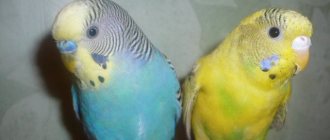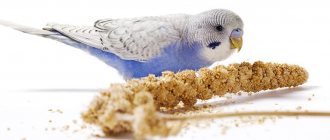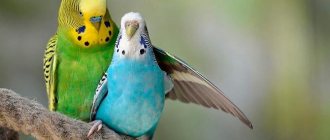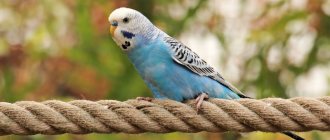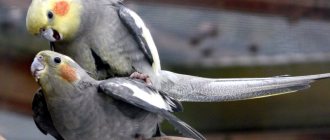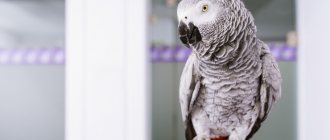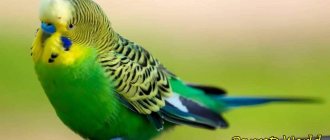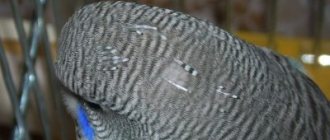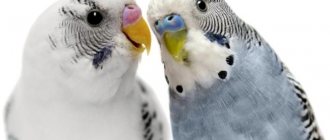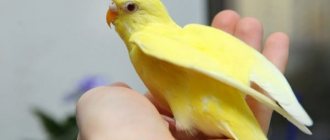Budgerigars become independent early. At the age of 1-1.5 months, the chicks already fly well and are able to feed without the help of their parents. Young birds rarely get sick, easily adapt to a new environment and quickly get used to people. At 10-12 months, birds reach sexual maturity, after which they are considered adults.
In order for the parrot to quickly take root and please the household for many years, it is better to choose “young animals”. To do this, it is important to know how to correctly determine age by external signs. The ability to distinguish a young bird from an adult bird will help you avoid mistakes or deception on the part of dishonest sellers.
Lifespan
The average lifespan of domestic budgerigars is 8-10 years. In favorable conditions and with proper care, they can live 12-15 years. There are often long-livers whose age has reached 20 years or more.
The lifespan of birds is positively influenced by the following factors:
- nutritious, balanced diet;
- regular feeding with mineral mixtures;
- quality drinking water;
- maintaining hygiene;
- a spacious, clean cage in a warm room that is periodically ventilated;
- proper lighting;
- systematic walks (it is advisable for the parrot to fly out of the cage every day);
- regular examination and timely treatment;
- frequent contact with the pet and friendly communication.
Parrots are sensitive and vulnerable birds. They pick up on a person’s negative emotions and have a hard time withstanding aggression and shouting. Stress can cause them illness and even death. Therefore, it is very important to show them kindness and care. In a friendly environment, parrots are active and sociable. They easily make contact, quickly learn to speak and willingly reproduce when there is a pair.
In the wild, budgerigars live 3-5 years. They often die from lack of food or become prey to predators. It is thanks to the creation of favorable conditions that domestic birds live much longer than their wild counterparts.
Budgerigar at home
Let's figure out what conditions need to be created for the parrot to make him as comfortable as possible:
Cage structure
These birds need a free cage. For one pet, choose an enclosure whose size will be at least 35 cm in height, 30 cm in width and 40 cm in length. However, experienced breeders recommend purchasing a cage twice the size of these parameters so that the parrot can flutter inside.
Place it at your height in a room that is well lit. Pets require long daylight hours: 10–14 hours depending on the time of year.
When cold weather sets in and daylight hours are shortened, use additional light sources. At the same time, it is forbidden to place the cage on the windowsill, since the parrots can catch a cold.
Budgerigar: Pixabay
To prevent your pets' claws from getting stuck between the bars, choose an enclosure with a solid bottom. Place wooden perches inside the cage. Avoid plastic items. Wooden ones will help parrots to grind down their claws.
Be sure to place the drinking bowl, which is secured to the rods. Every day, before adding water to it, rinse the device with a solution of baking soda and hot water.
Provide feeders for grains and soft foods in the cage. Do not forget about the stone on which the parrot will grind its beak. In summer, breeders recommend placing a swimming pool in the enclosure. Birds will be delighted with various toys: swings, bells, climbing frames. To make cleaning the cage easier, equip it with a tray that extends.
Budgerigar: Pixabay
Wash the enclosure and the equipment inside. After purchasing items, wash them with hot water and soda, discarding any cleaning products. If the parrot lives alone, hang a mirror from the ceiling of the enclosure with which the pet will talk.
Methods for determining age
With the onset of maturity, the appearance of parrots remains almost unchanged. Therefore, the younger the bird, the easier it is to determine its age. The first molt takes place from 3 to 5-6 months (it is called juvenile). Before it begins, the chick has pronounced differences from the young and adult individuals.
There are a number of distinctive signs by which you can determine how young a bird is.
Voskovica
Parrots have an area above their beak called the cere. As the first months of life progress, its color changes, making it possible to determine the age of the chick and its gender.
How the color of the cere changes:
- Females . From birth to 2.5-3 months, the beak is soft purple, pale pink or blue. There are white or light-colored circles around the nostrils. As the wax grows older, it turns brown or beige. The nostrils retain a white edging.
- Males . Barely fledged chicks have a bluish or light purple cere (sometimes pink). There are no circles around the nostrils or they are barely visible. During the first molt, the color of the beak changes and becomes bright blue.
This method of determining age is excellent for most species, except for certain mutation breeds (including albinos and lutinos).
Eyes
In chicks, the eyes remain black until 5-6 months. As you grow older, white irises begin to appear around your eyes. In some species it occurs at 10-12 months.
It is impossible to determine the age of a young parrot from the eyes with an accuracy of up to a month. If there are no circles around the eyes, the bird is definitely less than 1 year old. This method should be used as an auxiliary factor.
Beak
An adult parrot has a uniform yellow beak, sometimes with a greenish tint. Chicks are born with a black beak or have black spots or dark stains on it.
Only very young individuals can be distinguished by this feature. Often the beak becomes yellow already at 2-3 months, when the bird is still young.
Sometimes sellers resort to tricks and tint the surface of the beak of an older individual. Therefore, it is important to examine the parrot comprehensively, and not to determine the bird’s age by one indicator.
Plumage
In chicks, a wavy pattern covers the entire head. “Waves” start from the very eyes and reach the neck. During molting, the waviness gradually disappears, and by 8-10 months the head becomes smooth.
Up to 1.5 months, the youngsters have sparse plumage and dull colors. The contrast is especially visible when there are adult birds nearby. But by 2 months the feathers become thick and fluffy, evenly and tightly adjacent to each other. A plain “cap” on the head indicates that the juvenile moult has already passed.
Paws
The paws of young individuals have smooth, smooth skin. The presence of dense scales can be seen at close range. The same cannot be said about the skin of adult birds. With age, the scales become pronounced, the skin loses its smooth structure and becomes noticeably rougher.
If the paws are covered with bumps and growths, then the bird may be sick.
Tail
The younger the bird, the shorter its tail. Feathers in this area grow more slowly than on the body. A parrot can acquire its final tail length either at 3 months or at one year of age.
A bird’s tail can be trimmed to visually “rejuvenate” it. Also, tail feathers sometimes fall out as a result of disease (or they are plucked by the bird itself). These factors must be taken into account during the inspection.
Voskovitsa: finding the differences
The main sign that allows you to understand how to distinguish a boy’s budgerigar from a girl’s. Color of the beak wax.
But the younger the bird, the less informative this sign is. Boys and girls up to forty days cannot be distinguished by their cere. In males in the second month of life, the skin growth gradually takes on a delicate pinkish-violet hue. By six months he turns blue. However, in atypical representatives of the species the cere may not change color.
READ What can budgies eat from fruits?
And young girl budgies, having reached forty days old, show a whitish-blue or beige wax, with a white highlight near the nostrils. In a maturing female, this color changes to brown. Sometimes, under conditions of stress or molting, the color of the beak may become blue, but then the color returns to normal.
Other signs
Most species of parrots have spots on their throats that are commonly called “beads.” When young they are dark in color with blurred edges. As the bird matures, the spots become black with a clear outline.
When a parrot reaches 1 year of age, its size from head to tip of tail is on average 18-20 cm. Young parrots look smaller even upon visual inspection. This indicator should not be regarded as the main one. Since there are certain types of wavy rocks that are small in size.
Ornithologists and experienced breeders say that the best way to avoid errors in determining age is to look at a bird in all respects, and not just by one (for example, only by the color of the wax or by the eyes). There are more than 200 varieties of budgies, and each of them has its own characteristics.
Chicks at the age of 1-1.5 months already know how to navigate in space and fly well. Therefore, if a parrot moves uncertainly, this is evidence of its illness, not its youth.
Results
When choosing a budgie, it is advisable to take into account some signs that allow you to determine the sex and age of the bird. This is relevant if a bird is selected for subsequent breeding or for learning to speak.
You can get the necessary information yourself to avoid being deceived by careless sellers. To do this, the coloring, condition of the plumage and other external parameters of each bird are taken into account.
If you cannot determine gender and age, then it is advisable to contact only professional and well-known breeders.
Development by months
In the first months after birth, the appearance of budgerigars changes noticeably. Using the table, you can quickly study the changes taking place:
| Age of budgerigar | Cerise color ( male (1), female (2)) | Eyes | Beak | Drawing on the head |
| Up to 1.5 months | 1) pale pink or purple 2) blue or pink, circles around the nostrils | Eyes completely black | Beak black (some with a black tip) | The wavy pattern of plumage begins from the cere |
| 1.5-3 months. | 1) blue or purple 2) pink or light brown, circles around the nostrils | Eyes completely black | The beak begins to turn yellow, black spots remain | Wavy plumage starts from the cere |
| 3-4 months | 1) blue or dark lilac 2) brown or beige | Eyes completely black | The beak is yellow (sometimes with a green tint) | The first molt, during which the area from the cere becomes smooth |
| 5-8 months | 1) bright blue or purple 2) brown or beige | A white (or light) iris begins to appear around the black eyes | Yellow beak | The waviness “recedes” to the crown, a smooth “cap” is formed on the head |
| Over 8 months | After 8 months wax color does not change | The white edging around the black eyes acquires clear contours | Yellow beak | The hat is smooth, one-color, wavy pattern starts from the neck |
Most varieties of budgerigars already have a fully formed appearance by the age of 8 months, which remains unchanged in subsequent years.
From reputable breeders, each pet has a personal ring. It is put on on the 9th day after the birth of the chick. The ring displays the main information about the parrot and its breed. When purchasing, it is important to make sure that the hoop is solid, without any signs of tampering.
Plumage
How to find out the age of a budgerigar by its plumage? At one and a half months, the chick has already formed its plumage; at this age, the parrot should be, as they say, “feather to feather.” In the case when the seller claims that the feathers have not yet “fully grown”, this should be confusing, since perhaps the bird is simply sick or old. The plumage of young individuals is less contrasting than that of adults and is dull.
However, with age it becomes brighter and clearer. At 4-6 months, parrots shed their “chick plumage” and acquire mature plumage.
Exceptions
Varieties of budgerigars are divided into 2 large groups. Group 1 includes all types of birds with normal waviness (different colors have their own subgroups). Group 2 includes breeds of parrots that were subject to various mutations and did not retain the wavy pattern. These include the following types:
- birds with opaline color;
- pieds;
- albinos;
- lutinos;
- lacewings;
- harlequins and others.
Parrots of mutation breeds have their own characteristics, so determining their age can be more difficult. Each type has its own characteristic features, namely:
- the wavy pattern on the head is almost always absent; the “cap” adorns the head of both juveniles and adults;
- eyes remain black from birth until old age;
- Lutinos and albinos have red eyes throughout their lives;
- the beak is yellow at birth, or the black color disappears during the first 3-4 weeks of life;
- the cere changes color in the first months only in females (its colors are the same as in ordinary wavy breeds), and males at any age retain the beak pink, white or blue.
Therefore, in recessively variegated and pure parrots, age is determined by the following indicators:
- tail length;
- size of the individual;
- condition of the skin on the paws;
- density and structure of plumage.
Non-standard cases also occur among birds from group 1 with normal undulation. There are chicks that were born with an iris around the eyes or with a bright blue cere. In order not to make a mistake, it is important to consider the parrot according to all the main parameters.
Exceptions to the rules
In the variety of budgerigar breeds, there are mutation breeds, so-called Eno (including lutino, albino), still recessively colored parrots, and purebred parrots for which the methods described here are not suitable for age determination.
There are exceptions to the rules not only for mutations, but also for standard budgies. Here is a photo of a young male, 2-3 months old, who does not yet know what molting is, but already has blue wax and white irises - signs of a mature male:
Signs of an older bird
If a parrot at the age of 8-10 months can be easily confused with an individual that is already 3-5 years old, then you can recognize an old bird.
Signs of an elderly bird:
- over the years, the plumage around the eyes disappears;
- the pupil is cloudy, often with a whitish spot in the middle;
- the plumage loses its rich color, becomes dull, and bald patches appear in places;
- the tail has bald spots (sometimes there are no feathers at all).
Behavior also reveals old age. “Old people” are not so active and inquisitive, they move little, they prefer to sit, occasionally flying to the next perch.
Conclusion
If you decide to buy a budgie, then it is best, of course, to choose a young individual, since it will be able to adapt faster and will be more mobile and active. But you shouldn’t take small chicks with you either, as feeding problems may arise.
It is very difficult to determine the exact age of a parrot older than three months, since the first molt occurs during this period. But it is also possible - by the color of the beak and wax. The age of a bird older than one year can no longer be determined. The only thing that can be said is whether the bird is old or still young based on the texture of the skin on its legs, plumage and behavior.
In the case of lutino and albino, it is even more difficult to determine the age, so when buying a bird you should only contact trusted sellers and breeders who will not lie about the age and health of the bird.
Age of a parrot by human standards
Among other species from the Parrot family, budgerigars cannot be called long-livers. There are many breeds whose representatives live for decades. But when compared with human life, wavy individuals live to a ripe old age.
The age ratio between humans and parrots is presented in the table:
| Budgerigar | Human |
| 1 month | 7 months |
| 3 months | 1 year 9 months |
| 6 months | 3 years 6 months |
| 9 months | 5 years 3 months |
| 1 year | 7 years |
| 2 years | 14 years |
| 3 years | 21 years old |
| 4 years | 28 years |
| 5 years | 35 years |
| 6 years | 42 years |
| 7 years | 49 years old |
| 8 years | 56 years old |
| 9 years | 63 years old |
| 10 years | 70 years old |
| 11 years | 77 years old |
| 12 years | 84 years old |
| 13 years | 91 years old |
| 14 years | 98 years old |
| 15 years | 105 years |
The peculiarity of budgerigars is to maintain their appearance and beauty throughout their lives. They are energetic and curious, sociable and often talkative. Pet birds can become true friends in the home.
In order for a parrot to please its owners with its company for as long as possible, it is better to acquire it at a young age. To do this, it is important to study all the distinctive characteristics. Armed with knowledge, you can safely go in search of your future pet.
Care and maintenance
Of key importance in the care and maintenance of budgies are: selection of the cage, its arrangement and location in the apartment, as well as the preparation of the diet.
Here are some parameters that you should pay attention to when choosing a cage:
- rectangular shape;
- the length is greater than the height (this will make it possible to fly between the perches);
- horizontal rods are better than vertical ones, because it is more convenient to climb on them;
- Different sources give different requirements for minimum sizes, but everyone agrees on one thing - the larger the apartment, the better;
- inside it is necessary to place a drinking bowl, feeders and a sufficient number of toys;
- after placing accessories in the cage there should be enough free space;
- the lattice house does not need to be placed next to radiators, household appliances, in the kitchen, in direct sunlight or in a draft.
In the material for cages for budgies, you can familiarize yourself with other recommendations, as well as see a list of specific models of lattice apartments with photographs and a brief description.
When it comes to how to care for budgies, you need to think about what the bird will do in your absence. Parrots are animals that have highly developed social relationships. Communication for them is a necessary component for a full life, so the owner must devote time to his pet every day. In bird communities, the position against solitary keeping of birds is actively promoted. According to experts, for normal social relations it is permissible to keep 2 boys or any number of couples (a boy plus a girl). But it is not recommended to keep two girls together.
You will also need to provide your pet with a sufficient number of toys that will help him spend his time more interestingly and release pent-up energy. There are many types of toys, here are the most popular:
- developmental (or forage) - based on the instinct of animals to obtain food, where the task of the winged animal is to perform some actions in order to gain access to the delicacy inside;
- for the paws and beak - various chews, the main purpose of which is to be chewed and broken;
- musical - from simple bells to complex interactive models with motion sensors;
- ladders, swings, ropes - everything on which you can hang, dangle, or climb.
In the material on toys for budgies you can learn more about the existing types of play accessories, descriptions and photographs.
